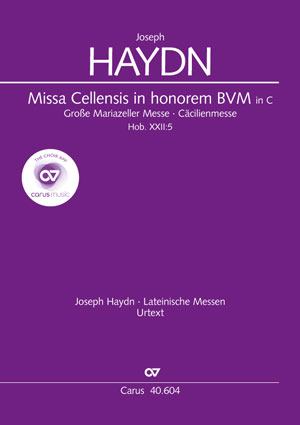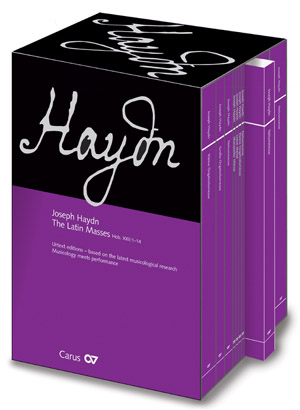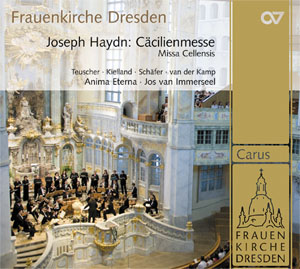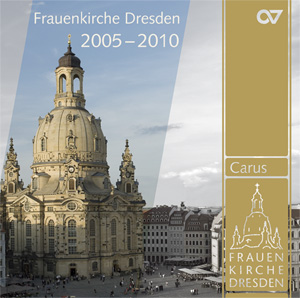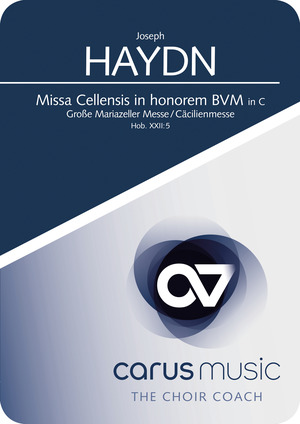
The outstanding features of Haydn’s Missa Cellensis in C major are the expression of heartfelt joy, the profoundly emotional and meticulous interpretation of the text, and the use of operatic techniques, for which Haydn was later accused of being "secular". As well as this, the Mass occupies an isolated position in Haydn’s oeuvre because of its mighty dimensions – it lasts about an hour, and the scoring includes trumpets and timpani. Anyone who studies this work will agree that it has "something indescribably touching" and "deeply moves the innermost of the soul", as a reviewer wrote in 1804.
Simply practice. Anytime. Everywhere.
Whether at home on your tablet or PC or on the road on your smartphone: with carus music, the Choir Coach, you always have your choral works with you to practice! With the carus music choir app, you can listen to your score together with a first-class recording on any device and easily practice your own choir part with a coach. With carus music, your concert preparation is easy, efficient and fun to master!
Performers: Lydia Teuscher (soprano), Marianne Beate Kielland (alto), Markus Schäfer (tenore), Harry van der Kamp (basso) – Chor "Anima Eterna", Orchester "Anima Eterna" – Jos van Immerseel
Contents
-
Composer
Joseph Haydn
| 1732-1809As Kapellmeister to Prince Esterházy, Haydn composed numerous instrumental works and various operas, as well as making important contributions to the genre of church music, including fourteen Latin masses, of which only twelve are authentic or complete; these are complemented by motets and offertories, two important Te Deum settings, two Salve Reginas, a Stabat Mater, and the different versions of the Sieben Worte des Erlösers am Kreuze. The masses were composed continually between 1749 and 1802, except for the years 1783–1795, and therefore constitute the genre with which Haydn was occupied over the longest period of time. The six (authentic or complete) masses composed before 1782 are stylistically very different, and as well as short Missae breves there are more extended masses with rich orchestral scoring; by contrast the six so-called late masses, written from 1796 onwards, form a comparatively homogeneous group of more extensive works scored for large forces. With his two great oratorios Die Schöpfung (The Creation) (1798) and Die Jahreszeiten (The Seasons) (1801) Haydn established the tradition of the German oratorio for middle-class music making. Personal details
-
Conductor
Jos van Immerseel
Jos van Immerseel was born in Antwerp, Belgium and studied piano, organ, singing, harpsichord (with Kenneth Gilbert) and orchestral conducting (with Daniel Sternefeld). In 1973 he won the first Harpsichord Competition in Paris. His widely praised historically informed performances are the result of a constant dialogue between practice, musicological research, in particular his study of rhetoric in music, and the study of musical instruments. Over the years Jos van Immerseel has amassed an impressive collection of historic harpsichords and pianos enabling him to choose the most suitable instrument for a particular performance, which he can also use on concert tours and for recordings. He has received some of the most prestigious awards for his recordings as a soloist, including a Diapason d’Or and Le Choc du Monde de la Musique. Van Immerseel directs master classes in Europe, Japan and the USA and teaches at the Schola Cantorum Basiliensis, the Conservatoire National Supérieur de Paris and the Sweelinck Conservatorium Amsterdam. He been a guest conductor with the Akademie für Alte Musik Berlin, Wiener Akademie, Musica Florea Prague and many other orchestras. In 1987, Jos van Immerseel founded his own orchestra, Anima Eterna. The orchestra and conductor have made a large number of prize-winning recordings for the Accent, Channel Classics and Sony record labels, and since 2002, for ZigZagTerritoires, Paris. Personal details
-
Soloist - soprano
Lydia Teuscher
-
Soloist - alto
Marianne Beate Kielland
Marianne Beate Kielland (mezzo-soprano) studied singing in Oslo and New York with teachers including Barbara Bonney, and sang in masterclasses with Dietrich Fischer-Dieskau. As one of the leading Norwegian concert singers, she has performed with orchestras including the Oslo Philharmonic Orchestra, Israel Philharmonic Orchestra, Orchestre des Champs-Elysées, Concerto Köln and the Akademie für Alte Musik Berlin, as well as vocal groups such as RIAS Kammerchor, Collegium Vocale Gent and the Gächinger Kantorei. She has performed with conductors including Phillippe Herreweghe, Helmuth Rilling, Joshua Rifkin and Manfred Honneck and has sung at some of the leading festivals including the Haydn Festspiele Eisenstadt, Bregenzer Festspiele, Bruges Baroque Festival and the Bergen International Festival. Personal details
-
Soloist - tenor
Markus Schäfer
-
Soloist - bass
Harry van der Kamp
Harry van der Kamp has sung the entire solo and ensemble repertoires of the 16th to 18th centuries. He has given concerts under the batons of Leonhardt, Harnoncourt, Koopman, Herreweghe and Bruggen, as well as with the Hilliard Ensemble, Les Arts Florrisant, Cantus Colln, among others. Together with his Gesualdo Consort Amsterdam he has performed the entire madrigal oeuvre of the 16th and 17th centuries. Numerous inaugural recordings – including Sweelinck’s entire body of work – were highly praised. Counting Edison, Grammy, Echo, Diapason d’or and Midi prizes among his achievements, he was made a knight of the Order of the Netherlands Lion in 2010. In 2012, he was made an honorary citizen of Amsterdam. He is professor emeritus at the University of the Arts in Bremen, and maintains a demanding schedule as masterclass lecturer and competition judge. Personal details
Frequent questions about this work
 There are no questions and answers available so far or you were unable to find an answer to your specific question about this work? Then click here and send your specific questions to our Customer Services!
There are no questions and answers available so far or you were unable to find an answer to your specific question about this work? Then click here and send your specific questions to our Customer Services!


